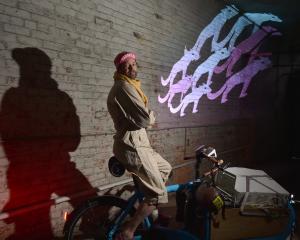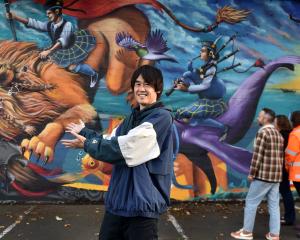You'd have to say an artist who pokes himself in the eye so he can record the colours he sees is fairly serious about his work.
Spencer Finch is certainly serious about light.
He goes to great lengths to create sensory experiences of light and colour using fluorescent tubes, coloured gels and video monitors.
"I love the ephemeral nature of light. It's minimal. It has this minimalist aesthetic that I find very appealing. It makes us think about that complex relationship between looking at something and our memory of that moment or event," he said in Dunedin last week.
"I wanted to break convention and take light from one place from another place, but still leave something to the viewer's imagination."
Finch uses a Minolta Colourimeter to record colour spectrums.
"It was developed in 1931 by the International Committee of Light and it measures the colour of ambient light on an XY scale," he explains.
Finch (45) was born in Connecticut and has been based in Brooklyn, New York, for the past 20 years.
A Dunedin Public Art Gallery 2008 international visiting artist, he has long been fascinated by New Zealand.
"As a child I had a dream about coming to New Zealand. I also did an assignment on New Zealand when I was about 8, in the third grade. So, this is the fulfilment of a dream for me," he says.
"This exhibition is a response to being located in an unfamiliar physical and cultural environment. It's all fascinating to me. I've been totally overwhelmed by the light and landscape here. I'm not the first person who's responded to it. Landscape painters in the 19th century were totally overwhelmed by the light and landscape here. They saw this intense light and reacted to it," he says.
"The light here is very white. At first, I thought it was yellow, but it's actually white. Everything just looks brighter here.
There's an incredible clarity. It illuminates across the spectrum, rather than shifting across it. Blues look bluer.
I saw a rainbow on March 29 and it was the biggest rainbow I've ever seen. It was huge.
"One of the alternate translations of 'Aotearoa' is 'big glaring light', which I think is a wonderful term."
His works reflect his New Zealand experiences over the past month.
Ice Cave uses fluorescent tubes to replicate the colour inside a Fox Glacier ice cave, while a melting mould of ice metamorphoses into a pool of bright blue water in Ice Chute.
"It's the exact reading of an azure sky over Fox Glacier. It breaks down the precise combination of colours," Finch says.
"I used eight drops of cobalt ink, half a drop of violet and one-and-a-half drops of grey ink to match the sky at that moment."
Described as a postmodern impressionist, Finch recreates the exact colour and intensity of light in a specific place and time.
"I was thinking about the 19th-century painters. What if, instead of painting a picture of a place, you could re-create the light of a place. If we were as sensitively attuned to the colour of light as we are to a convention like perspective. It's a way of thinking about how to represent landscape in an unconventional, but totally accurate way."
His projects are both bizarre and fascinating.
In 1995, Finch spent a day in psychoanalyst Sigmund Freud's examination room in Vienna, recording the colour of the spot on the ceiling patients stared at when they lay on Freud's couch.
The following year he flew above the Aegean Sea to map the exact colour of the sea and sky where Icarus is said to have plummeted to earth.
"My work doesn't capture a moment, it captures the fleetingness of a moment," Finch says.
"I became gradually interested in the sky, choosing each location for a specific conceptual reason".
Blue (Sky over Cape Canaveral, August 31,1994), was an attempt to match a very specific point in the sky where the Challenger disaster occurred.
"I think it also had to do with the idea of wanting to be a landscape painter, and then trying to think about landscape in a way that was non-traditional but had traditional 19th-century ideas."
Finch has also recorded his brain waves while watching a 1970s episode of Hawaii Five-O and then transmitted the image to Rigel, the bluest star in the night sky, which lies 960 light years away.
It is expected to arrive at Rigel in 2956.
"I feel like content has to be there, because I'm not interested in abstraction. Often the art experience is greatest when the audience has some way of entering the work: a familiarity or previous relation to a thing.
"But, I don't have some big message to convey. The focus is on the actual conventions of representation as a subject itself. The viewing experience becomes more about asking questions than receiving some sort of answer."
Finch says he is still searching for his own answers.
"That's the great thing about it. I now have much more sensitivity after spending so much time observing and being aware of light conditions. It's about being able to see the world in a richer and more complex way. I haven't fully figured it out yet, but I'm starting to."
Finch has degrees in literature and sculpture and often references poets and scientists in this themes.
"Poetry is a model of what art can do". [United States poet W.H.] Auden understood this in a profound way when he said.
'Poetry makes nothing happen. It exists in the valley of its making, where executives would never want to tamper'.
"There was a time, certainly in Newton's day, where there wasn't such a difference between artists and scientists. It was all drawn together in fields like alchemy".
"My interest in the scientific method has something to do with my wanting to quantify things and yet realising that's an impossible goal," he says.
"You don't have to know a lot about art to understand it. As soon as you capture something, whatever it is, is the moment you kill it."









![... we all become all of these things [installation view] (2025), by Megan Brady.](https://www.odt.co.nz/sites/default/files/styles/odt_landscape_small_related_stories/public/story/2025/03/1_we_all_become_all_of_thes.jpg?itok=nicA_yAm)


